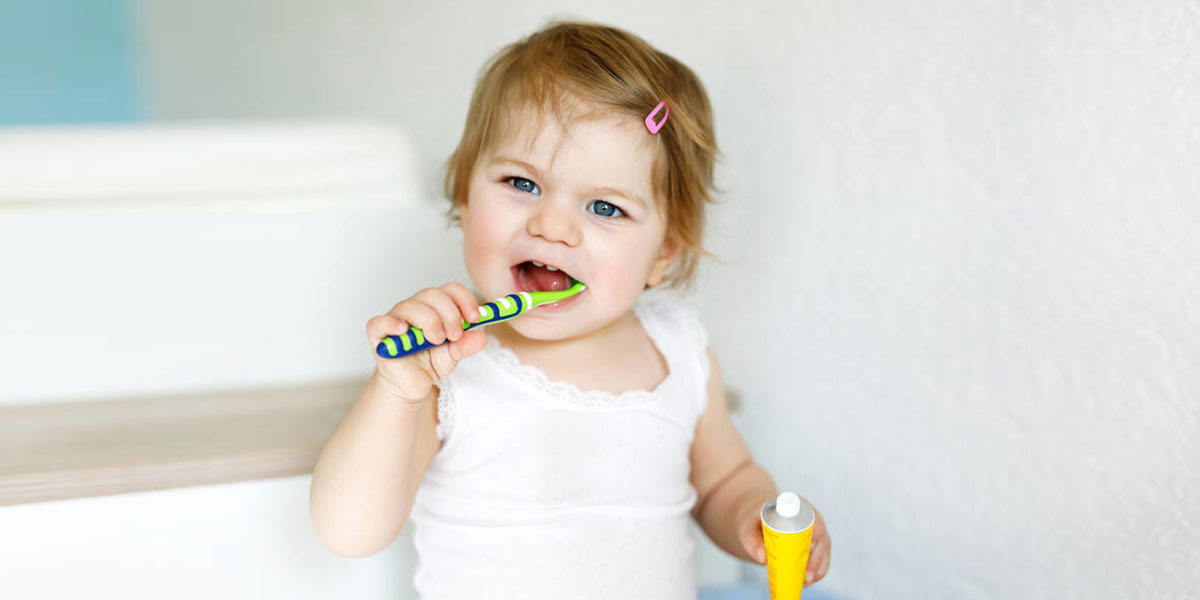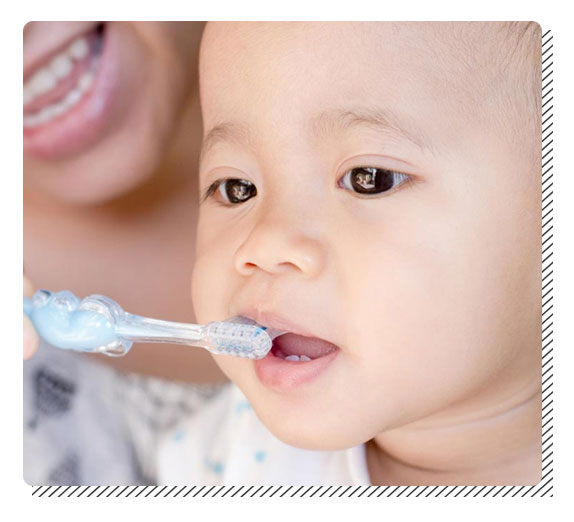When & How to Brush Baby Teeth

There are numerous stages for parents to keep track of during their baby’s first year of life. And oral and dental care of the child is one of them. It is essential to take good care of your baby’s teeth today. Not only because establishing good oral habits early on helps assure a lifetime of dental health. But also Decayed infant teeth can hinder proper nutrition and speech development. When rotten baby teeth fall out, they don’t hold an appropriate location for future teeth, which can cause permanent teeth to come in crooked.
It can be overwhelming as a parent to consider incorporating yet another item into your baby’s daily routine. However, learning how to brush a baby’s teeth will provide your child with lifelong benefits.
But are you aware of the recommendations for protecting those baby teeth and promoting good dental health? Continue reading to learn more about when to start brushing baby’s teeth & most importantly how to brush baby teeth.
When to Start Brushing Baby Teeth
It may be easy to put off worrying about your child’s smile until they have a mouthful of teeth. However, taking care of their oral hygiene should begin much earlier. You don’t even have to wait until your baby’s first tooth appears above the gum line to start preparing them for dental success.
There’s no reason to use a toothbrush if the baby doesn’t have any teeth, and using one on their bare gums might not feel very pleasant. It is essential to wash their gums as part of your regular oral hygiene routine until they have more teeth covering the area of their gums. It will also help to alleviate their pain as their teeth continue to break through their gums.
Brushing the baby’s teeth should begin as soon as the first tooth appears through the gums. Even after their first tooth appears, your baby’s gums will continue to be exposed to whatever they put in their mouth.
How to Brush Baby Teeth
1. Before your child has teeth

How to brush baby’s teeth? you ask. Brushing your baby’s gums with a washcloth and some water or a finger brush and some water is a good place to start. Gently wipe the gums and the front of the tongue with a clean, damp washcloth, gauze pad, or finger brush after meals and before going to bed.
Wipe gently around the gums, making sure to get under the lip area to help reduce bacteria build-up!
2. After the baby has teeth

When your child has teeth but cannot spit, use a damp brush to make gentle circles on the front, back, and top surfaces of all teeth and along the gum line. For children under the age of three, a smear of toothpaste can be used.
Teach your child to angle their mouth down so that the toothpaste dribbles out into the sink, a cup, or a washcloth. Encourage your child to spit out the toothpaste as soon as they can do so.
It is recommended that you brush baby teeth at least twice a day as soon as teeth appear above the gum line.
This is also an excellent moment to switch from a washcloth or finger brush to a child-sized brush with soft bristles. It will help you keep your fingers a bit further away from those razor-sharp incisors.
Also read: Baby Spitting up Clear Liquid | Reasons & Remedies
What to do when Baby Hates Brushing Teeth?
Brushing your child’s teeth can feel like a battle. They may be exceptionally resistant when the baby is teething, and their gums are sore and tender. If brushing their teeth becomes a challenge, here are some alternatives to consider:
- Brush your baby’s teeth in turns so that they feel more engaged and self-reliant. You can clean your child’s teeth first and then allow them to practice brushing afterward, or you can reverse the sequence.
- Even when they aren’t teething, the baby’s gums are sensitive, so try a soft washcloth and a gentle touch if the young one doesn’t seem to like the brush.
- Allow your child to choose a toothbrush that they enjoy. Such as one in their favorite color or with a picture of their favorite cartoon character on it makes the routine more exciting. Using a fun flavor of toothpaste can also help.
- Allow your child to have fun. Your baby will most likely be intrigued by the toothbrush or finger brush. Allow her to hold the brush and examine it at their own pace to pique her interest. They might even end up putting the brush in their mouth themself.
Baby Toothbrush and Toothpaste

Some parents prefer baby finger toothbrushes that include nubs that help clean teeth while still being gentle on the baby’s gums. Children’s toothbrushes have clear labels indicating the age and stage they are best for, so you won’t be caught off guard in the middle of the drugstore.
Toothbrushes for babies and younger toddlers often feature a broader handle that is simple to hold. They come in a variety of colors and characters to encourage children to brush. While silicone brushes are relaxing and gentle on the gums, they are not as effective at removing plaque from the teeth as nylon-bristle brushes.
Electric toothbrush manufacturers warn parents that electric toothbrushes are only appropriate for children above the age of three. So, for now, stick to a manual one.
When brushing your child’s teeth, use children’s toothpaste because adult toothpaste may contain too much fluoride. However, it should still have at least 1,000ppm (parts per million) of fluoride, which aids in the prevention and control of decay. Increase this when they are between the ages of three and six to a pea-sized amount.
Can babies use fluoride toothpaste?
The American Dental Association recommends fluoride toothpaste as safe and effective even for young children. It is vital, however, to use the recommended amounts. Don’t be concerned if your baby swallows some toothpaste. It will not cause any harm in such a small amount.
However, excessive fluoride consumption can damage tooth enamel over time, so it should not be introduced until the first tooth appears above the gum line. Before that, you can use water and a washcloth or a finger brush.
It is recommended that only a small smear of fluoride toothpaste, the size of a grain of rice, should be used for children under three. Encourage your child to spit out the toothpaste rather than swallow it as they grow older.
Should I give my baby a dummy?
Giving your baby a dummy is acceptable, but it should not be used after 12 months. Using dummies after this can lead to an open bite, which occurs when teeth move to accommodate the dummy. Some studies have found that using dummies for an extended period can have a negative impact on the way teeth grow. Overbite, malocclusion, crossbite, and open bite are all effects of dummies on baby teeth. They may also have an impact on your child’s speech development.
Discourage your child from talking or making sounds while holding a dummy or their thumb in their mouth, and avoid dipping dummies in anything sweet, such as sugar or jam.
Using an orthodontic or flat dummy is considerably better for your baby’s teeth, so that can help. These dummies are far better designed than previous dummies.
Our Advice
Long before your child is old enough to spit out toothpaste, you can begin to plant the seeds of good dental health. As with many things in life, practice makes perfect, so it may take some time and patience to perfect your baby’s tooth brushing routine.
When they turn one, or when their first tooth appears, it is time to take them to the dentist for the first time. The dentist will inform you that good oral care will keep your baby happy and their baby teeth healthy. That means your baby’s best friend is proper fluoride brushing, cleaning between teeth, regular dental checkups, and a nutritious diet, along with a teething ring. Brushing your infant’s teeth is not difficult or time-consuming, and it can save your child a lot of pain and struggle if you do.
Take heart, though, since when your child has a beautiful smile later in life, you will both be happy for your hard work and commitment to caring for their oral health.

Laura is a trained primary teacher who takes a profound liking in interacting with and bringing out the best in children. She is also an ISSA certified pediatrician with an extensive practice of over 12 years. Laura comprehends the needs of infants and now compresses her expertise into writing thorough parenting guides to aid new parents.





